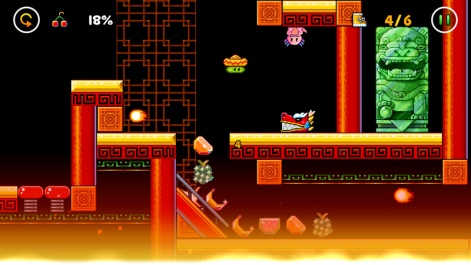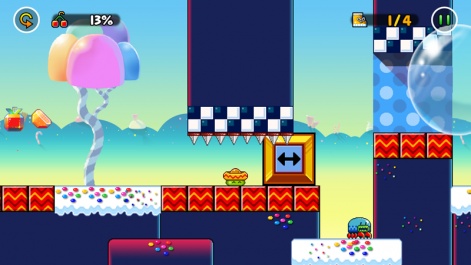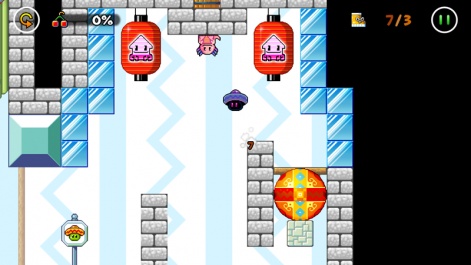And deservedly so - here was a small team, which then consisted of only three people, putting out a remarkably assured debut.
The design was bright and inviting, and the conception of the titular Bean as a constantly bouncing protagonist neatly sidestepped the slippery control issue of platformers on touchscreen.
However, there are inevitably always things to improve, and that’s what last year’s sequel aimed to address.
Take 2
Kumobius co-founder Tom Greenaway, producer of Bean Dreams, told us about some of the lessons learned by him and his team between Bean’s first outing and his 2014 return.
“At the very beginning of Bean’s Quest’s development we were just starting as a studio and it was our first game,” says Tom.
“I think, as is typical with many budding game developers, we made a few mistakes and one of them wasn’t thinking ahead very far.

“We poured a lot of energy and ideas into Bean’s Quest but we didn’t come up with a good structure or process at the start for creating updates to the game,” he goes on.
“After we finished Bean’s Quest, we looked back over it and thought: ‘Okay, there are actually a lot of ideas we didn’t explore. Stuff that felt like unfinished business.’
So in many ways Bean Dreams felt like a ‘Take 2’ of Bean’s Quest. How can we take those ideas and refine them?”
Birdie, eagle, bogie
Of course, one of the concepts behind Bean’s Quest which did strike gold - certainly an area for gentle refinement rather than overhauling - was the golf-style par for each level, which encourages you to be particularly economical with how many bounces you use to reach the end goal of each stage.
The idea of jump par as an alternative metric popped into our heads and it just made perfect senseTom Greenaway
“With Bean’s Quest, we iterated on the original first world of content several times,” Greenaway recalls.
“During one of those iterations - in which the stages were considerably longer than they are in the final version - we had the idea of a speed-run or time-attack mode like classic games had.”
“Almost immediately the idea of jump par as an alternative metric popped into our heads and it just made perfect sense. This discovery actually caused us to redo the entire first release of Bean’s Quest - which, admittedly, was a small amount of content originally.”
“It was pretty clear as soon as we discovered that gameplay element that it would be the crux of the game design. Intentionally designing levels around that concept and also balancing other interesting achievements like the fruit and the axolotl is pretty interesting.”
Jumping ahead
So, the groundwork was set with Bean's Quest, and the press had given a near-universal thumbs-up to the young studio.
Talking with Tom, you get a real sense of Kumobius as a studio feeling its way through game development, constantly learning and improving with no formal experience, and the intervening period of three years between Bean’s Quest and Bean Dreams was clearly one of developmental significance for all the team.

“Making a sequel requires a strange balance between creating a great experience for new players who are unfamiliar with your earlier game and simultaneously providing a fulfilling experience for veterans,” he explains.
“We’ve definitely grown as a studio and as individuals in terms of our skills. I think the skill area we’ve all developed the most in has been game design. Probably because none of us had formal game design schooling, training, or even work experience.”
“Literally, the original Bean’s Quest was built by a team of people who really didn’t know how to formally design a game. But I think, in contrast, our later work - including Bean Dreams - really speaks for itself in terms of our skills in design.”
Ninjas and chilli pepper
Indeed, the selection of worlds in Bean Dreams is a diverse one, ranging from the fairly conservative design of the Mario-like Fortune Fields to the more unusual areas, such as Dungeon of Dreams.
I asked the two level designers of Bean Dreams, brothers James and Tom Greenaway, their personal favourites, and their responses reflected how much more of a modern game it is than its predecessor.
Indeed, while Bean's Quest wasn't really set up to receive new content via updates, leading to a lengthy delay in the distribution of new levels, the pair assured us that the best is yet to come for Bean Dreams.

“I think my favourite worlds haven't been released yet,” says James.
“There are some great stages we have ready for updates that expand on the chilli pepper mechanic and really bring some crazy puzzles to that, and some really great designs revolving around magnetic floors.”
My favourite worlds haven't been released yet.James Greenaway
“As for the stages in the current version, I think my favourite is Marble Mountain. It was unusual because it was overhauled quite late in development to add the floating fans, which turned out to be a definite improvement.”
Tom echoes his brother and co-designer's excitement about the upcoming updates.
“I think of the new worlds we have planned I am most excited about the next bath house world which introduces the ninja suit power,” Tom tells us. This new power-up allows the player to roll up walls and jump using a wall-jump technique.”
“Of the original set of worlds we released I would probably say Beach Bazaar, which introduced the first power-up: the chilli pepper. Again, I think it’s because it really breathes new life into the game mechanics.”
Small team, high workrate
Comparing the raw gem of a debut that is Bean’s Quest with its polished sequel is perhaps the greatest indicator of how the Kumobius team has grown.
But Tom explains that there’s a lot of learning going on behind the scenes, too, with the diminutive team - now four strong, and looking to hire - actually taking on multiple roles during the development of Bean Dreams.
“In our team we don’t have professional audio knowledge, so we have always worked with external musicians for our games,” says Tom, explaining one of the very few elements which the team outsourced.
“The soundtrack to Bean Dreams was composed by Flashygoodness and he did an amazing job. He was the original composer of Bean’s Quest and his skill, too, has really developed in the past few years, which is very obvious when you listen to Bean Dreams.”
“In terms of internal division of work, there are four of us in the team now: 2 programmers, 1 artist and 1 producer. We all share the game design hat but level designs were primarily handled by our artist and me, the producer.”
“I’d say we all share a few different roles, but I in particular seem to juggle the largest variety of roles - I do business development, game design, level design, UI design, marketing, PR and some tools development.
"I also cut our trailers, actually. That’s another skill I taught myself in the past few years.”
Funding friend
However, despite its creative independence, the Kumobius team did receive assistance of a different kind during the development of Bean Dreams.
The Australian games industry would not be where it is today without Film Victoria’s assistance.Tom Greenaway
“We received some funding from Screen Australia to assist primarily in the production of the game,” says Tom. “We also received some funding from the state government body called Film Victoria to assist in some marketing expenses.”
“Sadly, the Screen Australia funding was prematurely axed shortly after a change in leadership in Australia,” he goes on to reveal.
“This is a terrible shame because there have been a lot of success stories out of that funding, not just including us, but other studios like Defiant Development with the recent Hand of Fate and the consistently awesome Tin Man Games guys.”
“Film Victoria has been around for quite a while and they really understand games both as an art form and as a business, which is really important.”
“The Australian games industry would not be where it is today without Film Victoria’s assistance, and I cannot speak more highly of the importance and dedication of their staff’s efforts.”
Out in the wild
The Christmas period is an incredibly competitive time to release a game, and one that even the biggest developers often shy away from.
So why did Kumobius decide to launch its premium-priced indie game at such an intense and busy time, in the December of last year?
“Christmas can be really tough,” agrees Tom. “I think if you’re a well-known indie you can be seen above other releases at that time, but if you’re releasing your very first game I’d advise people to stay away from that time period.”
“For Bean Dreams we released in a week with very tough competition, including the new Peggle and the official Game of Thrones game from TellTale Games, but we still did really well and Bean Dreams has actually been our most successful launch to date.”
How successful exactly is that, then?
“Bean Dreams has already made back its development costs and it’s continuing to sell well,” Tom assures us. “Kumobius is pretty sustainable now, we hired our first employee last year, and we’re hiring again right now actually.”
Kumobius has found itself, perhaps unwittingly, at the forefront of Apple's latest push towards premium gaming with the inclusion of Bean Dreams in its 'Pay Once & Play' promotion.

However, Tom actually has a very healthy attitude towards premium and free-to-play monetisation and, while premium is paying the bills now, he by no means rules out free-to-play as a viable model for future projects.
“Regarding premium games on mobile as a whole, I think it really depends on the game, the scope of the work and the skills of your team whether developers can find a place for themselves on phones and tablets,” says Tom.
“I do believe there will continue to be areas for premium games but I also believe that if you want to be very successful then you have to move to F2P - and I think it's important that people drop the stigma attached to that.”
Bean Dreams has already made back its development costs and it's continuing to sell well.Tom Greenaway
“Obviously there are some games that are very aggressive in terms of their monetisation, but then there are recent examples of F2P games that really aren’t aggressive at all and have still enjoyed remarkable success, such as Hipster Whale's Crossy Road.”
“To achieve that path, we must all reconsider what we expect from F2P monetisation.”
A spring in its step
A couple of months on from its release, and it's difficult to consider Bean Dreams anything other than a success.
Developed by a small team in what was roughly “an 18 month development period from start to finish,” the game is said to be drawing consistently good revenue from its premium price-tag, it's been featured by Apple, and even given the ultimate seal of approval by the press with comparisons to the legendary Super Mario games.
But the best thing is that it's not over yet. The excitement is palpable when Tom and James Greenaway talk about the upcoming updates, and players know that they won't have too long to wait.
He's quested, he's dreamed; now the only question is what Bean, and his creators at Kumobius, will be aiming to achieve next time. Whatever that may be, based on current form, we wouldn't bet against it coming true.
















